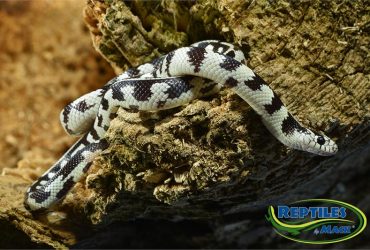Sand Boa Care Sheet
Scientific Name: Eryx colubrinus loveridgei
Native to: Africa and the Middle East
Maximum Length: Adult boas reach 1 to 3 feet long, depending on species.
Life Span: 20+ years
Characteristics:
Sand Boas are excellent reptile pets. They stress out more easily than other boas and most keepers consider them display pets rather than pets to handle often. Kenyan Sand Boas are the most commonly available species and they now come in a variety of different colors and markings including Albino, Paradox, Dodoma, and Nuclear. These snakes are the perfect size for pet owners who want a boa species but one that stays small. These boas are nocturnal so they are very active at night. Make sure you provide 2-3” of sand for your boa to dig into.
Care Tips:
Enclosure: Baby Sand Boas can live in a 5-20 gallon terrarium depending on the species. As the boa gets older the
enclosure should be no shorter than 1/2 the length of the snake. Make sure the terrarium has a well-ventilated top. Sand Boas love to dig and bury in the sand.
Substrate: Use Sani-chips or Carefresh for these boas. Do not use cedar shavings or bark nuggets as they are toxic to reptiles.
Habitat: Sand Boas love to dig. You can add flat rocks (resting firmly on the bottom of the terrarium), fake succulent plants, and other décor for the snake to explore.
Temperature and Lighting: Daytime temperatures should be around 84-90° F. Night time temperatures should not drop below 78° F. UVB is not a necessity for these nocturnal snakes, but will not be harmful to your boa. Use a undertank heater. You can use fluorescent lights and leave them on for 8-12 hours a day. During the night, use an infrared heat lamp to view your snake.
Food and Water: Boas eat rodents no larger than the snake’s girth. Baby Sand Boas should be fed once a week. Pinky mice and small mice are ideal meals for baby Sand Boas. The size of food needed will depend on the species of boa. It is best to feed your boa frozen/thawed rodents. For Sand Boas, you must make sure the thawed rodent is not damp as sand will stick on it and the boa will eat the sand. Most Sand Boa keepers feed their boas in a small paper bag or in a plastic dish and then return it to their enclosure. This prevents the boa from eating sand and causing an impaction which can be potentially life-threatening. Also, a live rodent can cause harm to your boa if it tries to fight back. Provide a very shallow dish of fresh water and make sure it stays clean. These boas are desert dwellers and need very little drinking water. We do suggest keeping a small dish of water in with them just in case.
To download or print this care sheet – Click link: Sand Boa Care Sheet
[metaslider id=3917]




